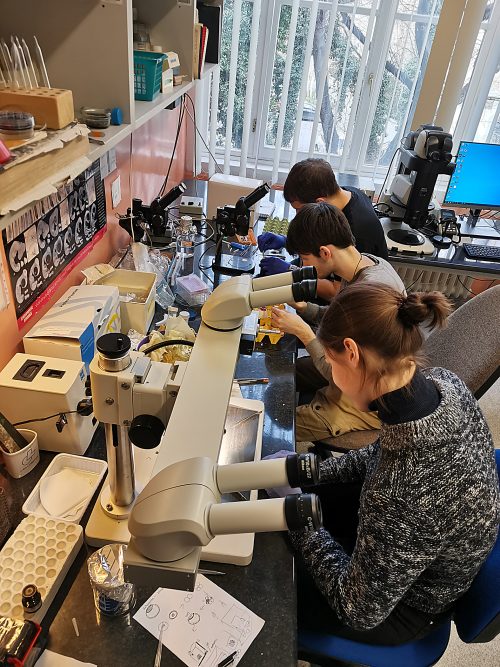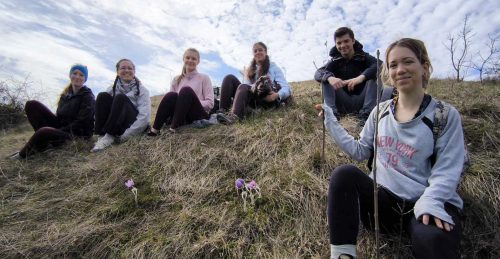Lab meeting with the Nagy lab
Posted by the Node, on 30 May 2024
This is part of the ‘Lab meeting’ series featuring developmental and stem cell biology labs around the world.
Where is the lab?
Our lab is in the center of Budapest, based in the Department of Anatomy, Histology and Embryology, Faculty of Medicine, at the Semmelweis University, Budapest, Hungary.
The Nagy Lab website: https://semmelweis.hu/stemcell/en/
Research summary
Our lab’s principal research goals are to understand the development of the enteric nervous system (ENS) and gut-associated lymphoid organogenesis, using the avian embryo as the model system. The avian embryo is a versatile embryologic model that we have leveraged to identify the role of multiple factors on the migration, proliferation, and differentiation of enteric neural crest-derived cells as they colonize the intestine to form the ENS. Abnormalities in this process lead to neurointestinal diseases like Hirschsprung disease, a congenital disorder in which ganglion cells fail to develop in the distal gut, leaving newborns with a bowel obstruction. We perform a variety of avian embryologic methodologies, including chimeras, parabiosis, gene overexpression and gene silencing studies using siRNA-RCAS viruses to examine the role of the extracellular environment in the embryonic gut that regulate the mechanisms of neural crest derived stem cell differentiation during intestinal morphogenesis.
Secondly, our lab focuses on mechanisms that underlie lymphoid organ formation. This work also uses the avian embryo as the model system, and addresses the cellular, molecular, immunological and morphological aspects of the primary and secondary lymphoid organ formation. Our aim is to discover how the avian lymphoid organs are built, and how immunosuppressive diseases affect their organization.

Lab roll call
Nándor Nagy: As the head of the lab, my primary task is to ensure that everyone is enthusiastic about coming to the lab each morning. As a PI, I train the research staff to have the skills to execute research protocols competently. I am also a university professor responsible for leading the developmental biology course and teaching human anatomy classes for medical students.
Katalin Kocsis, associate professor: With decades of experience in teaching anatomy, histology, and embryology, I help students understand the complexity of the developing embryo. I am also providing the administrative background to our Developmental Biology course for medical students in both Hungarian and English programs.
Nóra Fejszák, post-doc: Using the avian embryo as a model system for early hematopoiesis, I investigate yolk sac stem cells in multiple avian species and their differentiation to tissue resident immune cells.
Viktória Halasy, PhD student: Currently I am writing my PhD thesis about the development of the extrinsic innervation of the colorectum.
Ádám Soós, PhD student: My main project is to establish the enteric neurosphere technique in the avian model system. I am responsible for the microscopy facility of our laboratory.
Emőke Szőcs, PhD student: I work towards understanding the inductive capacities of embryonic tissues and cell-cell interactions in forming primary lymphoid organs.
Zsanna Gecse, undergraduate student: As a third-year medical student, my task is to study the complexity of hindgut innervation, currently characterizing a new cell type in the mucosa of the avian hindgut.
Csenge Jurenka, undergraduate student: I joined the lab in the second year of medical school; I am trying to establish a novel Hirschsprung’s disease model to understand enteric neurocristopathies better.
Ábel Farkas, undergraduate student: I am a second-year veterinary medicine student. Since joining the lab, I started characterizing the development of the cloaca-associated lymphoid structure in domesticated birds.
Zsófia Bogya, undergraduate student: My student research project is to study the development of the dendritic cells in chicken primary lymphoid organs.
Réka Borbála Tóth, undergraduate student: I study bioengineering and try to understand the role of extracellular matrix proteins in the migration of enteric neural crest-derived cells.
Noémi Kegyes, lab assistant: I help with all ongoing projects in the lab, making sure everyone can continue their work with a smile on their face.

Favourite technique, and why?
Nándor: My favorite techniques in studying the embryo are microsurgery and imaging. Avian embryos are accessible during all stages of embryogenesis and there is a large repertoire of methodologies, including tissue grafting, retroviral-mediated gene transfer, electroporation, and embryo culture I use to perturb and analyze gene function during development. Microscopy is the best way to show the complexity of the developing tissues and organs. Analysis of both live organ cultures and fixed tissue samples using transgenic lines or multiplex immunofluorescence, complemented by microscopy at different resolutions enables the examination of developing organism across various scales, from intracellular ultrastructures to complex multicellular tissues.
Apart from your own research, what are you most excited about in developmental and stem cell biology?
Nándor: I believe that being a stem cell and developmental biologist at this time is filled with excitement. While there has been significant progress in studying the embryo, the underlying biology and causes of many congenital diseases are still not well comprehended. By combining various techniques and resources, adopting a multidisciplinary approach that includes careful clinical phenotyping, genetics, developmental biology, and regenerative medicine, we have the potential to truly advance our understanding and stem cell treatment of congenital diseases within the next 5-10 years. Our goal is to be at the forefront of this important endeavor.

How do you approach managing your group and all the different tasks required in your job?
Nándor: I am privileged to lead this lab with highly motivated young scientists driven by their unique interests. Balancing between administrative and teaching tasks, I always enjoy working with my PhD and undergraduate students in the lab. Enthusiasm and fun are essential in science, and I believe lab members should be self-motivated, choosing projects that interest them. I dedicate time to help new students to acclimatize to the lab and encouraging them to find a topic to study and develop new ideas over time. Weekly lab meetings, joint lab meetings with other research groups and spontaneous discussions provide a strong foundation for our work and support the collaboration between the lab members. In addition, one-on-one meetings with lab members ensure their individual success, which I highly prioritize.
What is the best thing about where you work?
Nándor: The familiar atmosphere and numerous opportunities for scientific collaboration with other research labs in Hungary and internationally.
Katalin: In this lab one can always get the help and encouragement that is needed to be successful in the academic and educational fields.
Nóra: It is great to encounter the wonders and fragility of life almost every day through chicken embryos enclosed in eggs, and I have the opportunity to share this experience with a cohesive and supportive lab team in which new and exciting ideas are generated continuously.
Viktória: Our lab community exudes enthusiasm, cheerfulness, and unity, resembling a tight-knit group of friends, thanks to exceptional leadership. We prioritize teamwork and the sharing of thrilling new findings.
Ádám: The environment is very cozy, the lab members are really supportive. It’s a bit like a second family.
Emőke: Trying to understand the developing embryo is such an exciting task. We approach this with the most diverse methods, which makes day to day lab work so much fun – all while doing this with a great team.
Csenge: Whenever I am working in the lab, there is always someone to ask for help, get some advice from, or just have a chat with, and this gives me a lot of motivation.
Zsanna: Working in the lab is a fantastic opportunity for me to familiarize myself with laboratory techniques that I would not normally study and to deepen my knowledge in the field of embryology. I also love the fact that whenever I go there, I see the smiley faces of my coworkers who are always there to help me with any difficulty.

What’s there to do outside of the lab?
Nándor: I love the vivid Budapest city and always enjoy its historical and multi-cultural hub character. I grew up in Transylvania (8 hours from Budapest), a historic eastern European region with truly wild mountain region, a land that is still rich in myths and legends. I love to go mountain hiking, visit castles and ruins, discover the various biodiversity, and spend time outdoors with my family. Budapest and Transylvania are the places to be!
Katalin: Living in the suburban part of the city with my family, we enjoy gardening around the house. Visiting the central part of the city is always like an interesting tour. Theatres, museums, the zoo – several exciting places to see frequently – not only in Budapest – but also in other parts of Hungary.
Nóra: Budapest is full of colorful life and offers a wide range of exciting indoor and outdoor activities. On workdays we sometimes go out for a coffee or an ice cream to a nearby park. During weekends I like to explore the hidden natural formations of forests around Budapest with my family. My favourite ones are the forests that belong to the floodplain of the river Danube.
Viktória: Beyond the lab, attending conferences and weekend trips always leads to memorable moments. During weekdays at night, we frequently chill out with activities like indoor rock climbing or ice skating in Városliget, the central park of Budapest.
Ádám: Our lab is close to the city center, making it convenient for us to unwind together outside of work. Whether it’s grabbing a drink at a local spot or engaging in activities like bouldering or hiking, there’s no shortage of options for us to bond and relax together.
Emőke: Budapest is a vibrant place; both city life enthusiasts and outdoorsy people can find activities to their taste. Just take a walk along the Danube in the evening, enjoy concerts, discover art galleries and museums, explore nature in the hills around Budapest, try kayaking on the river and have fun!
Csenge: There are some great bars near the lab, where we can celebrate after a successful conference, but Budapest itself gives great joy with its monumental buildings and wonderful scenery along the Danube.
Zsanna: I find Budapest the perfect place to be a university student, as the city is famous for its nightlife as well as its monumental historical heritage. Whether you are an extrovert who wants to meet friends every weekend at a new pub, or an introvert who wants to get lost in the museums, you will find your place here.



 (5 votes)
(5 votes)